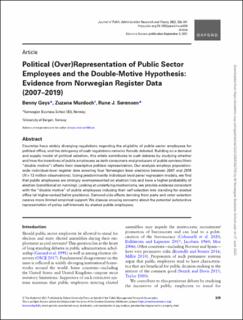Political (Over)Representation of Public Sector Employees and the Double-Motive Hypothesis: Evidence from Norwegian Register Data (2007-2019)
Journal article, Peer reviewed
Published version
Permanent lenke
https://hdl.handle.net/11250/3073386Utgivelsesdato
2021Metadata
Vis full innførselSamlinger
Originalversjon
10.1093/jopart/muab034Sammendrag
Countries have widely diverging regulations regarding the eligibility of public sector employees for political office, and the stringency of such regulations remains fiercely debated. Building on a demand and supply model of political selection, this article contributes to such debates by studying whether and how the incentives of public employees as both consumers and producers of public services (their “double motive”) affects their descriptive political representation. Our analysis employs population-wide individual-level register data covering four Norwegian local elections between 2007 and 2019 (N > 13 million observations). Using predominantly individual-level panel regression models, we find that public employees are strongly overrepresented on election lists and have a higher probability of election (conditional on running). Looking at underlying mechanisms, we provide evidence consistent with the “double motive” of public employees inducing their self-selection into standing for elected office (at higher-ranked ballot positions). Demand-side effects deriving from party and voter selection receive more limited empirical support. We discuss ensuing concerns about the potential substantive representation of policy self-interests by elected public employees.

